An Analysis of Spatial–Temporal Evolution and Propagation Features of Vegetation Drought in Different Sub-Zones of China
Abstract
:1. Introduction
2. Study Area and Dataset
2.1. Study Area
2.2. Dataset
2.2.1. In Situ Data
2.2.2. Remote Sensing Satellite Dataset
2.2.3. Atmospheric Teleconnection
2.2.4. Digital Elevation Model Data
3. Methodology
3.1. Vegetation Condition Index
3.2. Meteorological Drought Index
3.3. Extreme-Point Symmetric Mode Decomposition (ESMD)
3.4. Pixel-Scaled Trend Analysis Method
3.5. Rescaled Range (R/S) Analysis
3.6. Bivariate and Multivariate Cross Wavelet Transform Technology
4. Results
4.1. The Validation of VCI
4.2. Temporal Variations of Vegetation Drought
4.3. Spatial Distributions of Vegetation Drought
4.4. Vegetation Drought Trend Identification at the Pixel Scale
4.5. Propagation Features from Meteorological to Vegetation Drought
5. Discussion
5.1. Dynamic Relations between Vegetation Drought and Atmospheric Teleconnection
5.1.1. Bivariate Wavelet Coherence
5.1.2. Multivariate Wavelet Coherence
5.2. Uncertainties
5.3. The Possible Influence Factors
5.4. Advantages and Limitations
6. Conclusions
- (1)
- In 1999–2020, the vegetation drought presented an overall decreasing trend, while the performance was different in each subzone. Noticeably, the minimal VCI-value (0.41) was found in 2000, and the average monthly VCI was 0.36–0.46.
- (2)
- From spring to winter, the worst vegetation drought with minimal VCI-values appeared in the AV (0.47), AV (0.45), CTCF (0.49), and CDBF (0.38), respectively. Additionally, the three vegetation-drought-prone areas in China were the CDBF, CTCF and AV.
- (3)
- The pixel-scaled drought trend identification indicated that vegetation droughts were increasing in January and February and were decreasing from March to December on a monthly scale. On a seasonal scale, vegetation droughts were alleviating in each season across China.
- (4)
- The influence of atmospheric teleconnection on the formation of drought cannot be ignored. The results showed that PNA-ENSO-TPI had the strongest effects on the vegetation drought evolution process.
Author Contributions
Funding
Data Availability Statement
Acknowledgments
Conflicts of Interest
References
- Mishra, A.K.; Singh, V.P. A review of drought concepts. J. Hydrol. 2010, 391, 202–216. [Google Scholar] [CrossRef]
- Forootan, E.; Khaki, M.; Schumacher, M.; Wulfmeyer, V.; Mehrnegar, N.; van Dijk, A.I.J.M.; Brocca, L.; Farzaneh, S.; Akinluyi, F.; Ramillien, G.; et al. Understanding the global hydrological droughts of 2003–2016 and their relationships with teleconnections. Sci. Total Environ. 2019, 650, 2587–2604. [Google Scholar] [CrossRef] [Green Version]
- Mehdizadeh, S.; Ahmadi, F.; Mehr, A.D.; Safari, M.J.S. Drought modeling using classic time series and hybrid wavelet-gene expression programming models. J. Hydrol. 2020, 587, 125017. [Google Scholar]
- Jiang, T.L.; Su, X.L.; Singh, V.P.; Zhang, G.X. A novel index for ecological drought monitoring based on ecological water deficit. Ecol. Indic. 2021, 129, 107804. [Google Scholar] [CrossRef]
- Crausbay, S.D.; Ramirez, A.R.; Carter, S.L.; Cross, M.S.; Hall, K.R.; Bathke, D.J.; Betancourt, J.L.; Colt, S.; Cravens, A.E.; Dalton, M.S.; et al. Defining ecological drought for the twenty-first century. Bull. Am. Meteorol. Soc. 2017, 98, 2543–2550. [Google Scholar] [CrossRef]
- Wu, D.; Qu, J.J.; Hao, X.J. Agricultural drought monitoring using MODIS-based drought indices over the USA Corn Belt. Int. J. Remote Sens. 2015, 36, 5403–5425. [Google Scholar] [CrossRef]
- Wang, Y.J.; Fu, B.J.; Liu, Y.X.; Li, Y.; Feng, X.M.; Wang, S. Response of vegetation to drought in the Tibetan Plateau: Elevation differentiation and the dominant factors. Agric. Forest Meteorol. 2021, 306, 108468. [Google Scholar]
- Caccamo, G.; Chisholm, L.A.; Bradstock, R.A.; Puotinen, M.L. Assessing the sensitivity of MODIS to monitor drought in high biomass ecosystems. Remote Sens. Environ. 2011, 115, 2626–2639. [Google Scholar] [CrossRef]
- Kuri, F.; Murwira, A.; Murwira, K.S.; Masocha, M. Predicting maize yield in Zimbabwe using dry dekads derived from remotely sensed Vegetation Condition Index. Int. J. Appl. Earth Obs. 2014, 33, 39–46. [Google Scholar]
- Zambrano, F.; Lillo-Saavedra, M.; Verbist, K.; Lagos, O. Sixteen years of agricultural drought assessment of the BioBío region in Chile using a 250 m resolution vegetation condition index (VCI). Remote Sens. 2016, 8, 530. [Google Scholar]
- Agutu, N.O.; Awange, J.L.; Zerihun, A.; Ndehedehe, C.E.; Kuhn, M.; Fukuda, Y. Assessing multi-satellite remote sensing, reanalysis, and land surface models’ products in characterizing agricultural drought in East Africa. Remote Sens. Environ. 2017, 194, 287–302. [Google Scholar]
- Zhao, A.Z.; Zhang, A.B.; Liu, J.H.; Feng, L.L.; Zhao, Y.L. Assessing the effects of drought and “Grain for Green” Program on vegetation dynamics in China’s Loess Plateau from 2000 to 2014. Catena 2019, 175, 446–455. [Google Scholar]
- McEvoy, J.; Bathke, D.J.; Burkardt, N.; Cravens, A.E.; Haigh, T.; Hall, K.R.; Hayes, M.J.; Jedd, T.; Podêbradská, M.; Wickham, E. Ecological drought: Accounting for the non-human impacts of water shortage in the upper Missouri headwaters basin, Montana, USA. Resources 2018, 7, 14. [Google Scholar]
- Duo, A.; Zhao, W.J.; Qu, X.Y.; Jing, R.; Xiong, K. Spatio-temporal variation of vegetation coverage and its response to climate change in North China plain in the last 33 years. Int. J. Appl. Earth Obs. 2016, 53, 103–117. [Google Scholar]
- Bento, V.A.; Gouveia, C.M.; DaCamara, C.C.; Trigo, I.F. A climatological assessment of drought impact on vegetation health index. Agric. Forest Meteorol. 2018, 259, 286–295. [Google Scholar] [CrossRef]
- Xie, F.; Fan, H. Deriving drought indices from MODIS vegetation indices (NDVI/EVI) and Land Surface Temperature (LST): Is data reconstruction necessary? Int. J. Appl. Earth Obs. 2021, 101, 102352. [Google Scholar]
- Quiring, S.M.; Ganesh, S. Evaluating the utility of the Vegetation Condition Index (VCI) for monitoring meteorological drought in Texas. Agric. Forest Meteorol. 2010, 150, 330–339. [Google Scholar]
- Shao, Y.Y.; Zhang, Y.Q.; Wu, X.Q.; Bourque, P.A.; Zhang, J.T.; Qin, S.G.; Wu, B. Relating historical vegetation cover to aridity patterns in the greater desert region of northern China: Implications to planned and existing restoration projects. Ecol. Indic. 2018, 89, 528–537. [Google Scholar]
- Jiang, W.G.; Yuan, L.H.; Wang, W.J.; Cao, R.; Zhang, Y.F.; Shen, W.M. Spatio-temporal analysis of vegetation variation in the Yellow River Basin. Ecol. Indic. 2015, 51, 117–126. [Google Scholar]
- Zhao, J.; Huang, S.Z.; Huang, Q.; Wang, H.; Leng, G.Y.; Fang, W. Time-lagged response of vegetation dynamics to climatic and teleconnection factors. Catena 2020, 189, 104474. [Google Scholar]
- Kou, P.L.; Xu, Q.; Jin, Z.; Yunus, A.P.; Luo, X.B.; Liu, M.H. Complex anthropogenic interaction on vegetation greening in the Chinese Loess Plateau. Sci. Total Environ. 2021, 778, 146065. [Google Scholar] [CrossRef]
- Carter, G.A. Responses of leaf spectral reflectance to plant stress. Am. J. Bot. 1993, 80, 239–243. [Google Scholar] [CrossRef]
- Lin, Q.X.; Wu, Z.Y.; Singh, V.P.; Sadeghi, S.H.R.; He, H.; Lu, G.H. Correlation between hydrological drought, climatic factors, reservoir operation, and vegetation cover in the Xijiang Basin, South China. J. Hydrol. 2017, 549, 512–524. [Google Scholar]
- Mo, K.L.; Chen, Q.W.; Chen, C.; Zhang, J.Y.; Wang, L.; Bao, Z.X. Spatiotemporal variation of correlation between vegetation cover and precipitation in an arid mountain-oasis river basin in northwest China. J. Hydrol. 2019, 574, 138–147. [Google Scholar]
- Fan, Z.M.; Bai, X.Y. Scenarios of potential vegetation distribution in the different gradient zones of Qinghai-Tibet Plateau under future climate change. Sci. Total Environ. 2021, 796, 148918. [Google Scholar] [PubMed]
- Huang, W.H.; Wang, H.L. Drought and intensified agriculture enhanced vegetation growth in the central Pearl River Basin of China. Agr. Water Manag. 2021, 256, 107077. [Google Scholar]
- Venkataraman, K.; Tummuri, S.; Medina, A.; Perry, J. 21st century drought outlook for major climate divisions of Texas based on CMIP5 multimodel ensemble: Implications for water resource management. J. Hydrol. 2016, 534, 300–316. [Google Scholar]
- John, F.; Toth, R.; Frank, K.; Groeneveld, J.; Müller, B. Ecological vulnerability through insurance? Potential unintended consequences of livestock drought insurance. Ecol. Econ. 2019, 157, 357–368. [Google Scholar]
- Crausbay, S.D.; Betancourt, J.; Bradford, J.; Cartwright, J.; Dennison, W.C.; Dunham, J.; Enquist, C.A.F.; Frazier, A.G.; Hall, K.R.; Littell, J.S.; et al. Unfamiliar territory: Emerging themes for ecological drought research and management. One Earth 2020, 3, 337–353. [Google Scholar]
- Park, S.Y.; Sur, C.Y.; Lee, J.H.; Kim, J.S. Ecological drought monitoring through fish habitat-based flow assessment in the Gam river basin of Korea. Ecol. Indic. 2020, 109, 105830. [Google Scholar]
- Millar, C.I.; Stephenson, N.L. Temperate forest health in an era of emerging megadisturbance. Science 2015, 349, 823–826. [Google Scholar] [CrossRef] [PubMed]
- Deng, S.F.; Yang, T.B.; Zeng, B.; Zhu, X.F.; Xu, H.J. Vegetation cover variation in the Qilian Mountains and its response to climate change in 2000–2011. J. Mt. Sci. 2013, 10, 1050–1062. [Google Scholar]
- Guo, W.W.; Huang, S.Z.; Huang, Q.; Leng, G.Y.; Mu, Z.X.; Han, Z.M.; Wei, X.T.; She, D.X.; Wang, H.Y.; Wang, Z.X.; et al. Drought trigger thresholds for different levels of vegetation loss in China and their dynamics. Agric. Forest Meteorol. 2023, 331, 109349. [Google Scholar] [CrossRef]
- Zhang, Y.; Hao, Z.C.; Feng, S.F.; Zhang, X.; Xu, Y.; Hao, F.H. Agricultural drought prediction in China based on drought propagation and large-scale drivers. Agric. Water Manag. 2021, 255, 107028. [Google Scholar]
- Bae, H.; Ji, H.; Lim, Y.J.; Ryu, Y.; Kim, M.H.; Kim, B.J. Characteristics of drought propagation in South Korea: Relationship between meteorological, agricultural, and hydrological droughts. Nat. Hazards 2019, 99, 1–16. [Google Scholar]
- Wu, J.W.; Miao, C.Y.; Zheng, H.Y.; Duan, Q.Y.; Lei, X.H.; Li, H. Meteorological and hydrological drought on the Loess Plateau, China: Evolutionary characteristics, impact, and propagation. J. Geophys. Res. Atmos. 2018, 123, 11569–11584. [Google Scholar]
- Wang, F.; Wang, Z.M.; Yang, H.B.; Di, D.Y.; Zhao, Y.; Liang, Q.H. Utilizing GRACE-based groundwater drought index for drought characterization and teleconnection factors analysis in the North China Plain. J. Hydrol. 2020, 585, 124849. [Google Scholar]
- Huang, S.Z.; Li, P.; Huang, Q.; Leng, G.Y.; Hou, B.B.; Ma, L. The propagation from meteorological to hydrological drought and its potential influence factors. J. Hydrol. 2017, 547, 184–195. [Google Scholar] [CrossRef]
- Xu, Y.; Zhang, X.; Wang, X.; Hao, Z.C.; Singh, V.P.; Hao, F.H. Propagation from meteorological drought to hydrological drought under the impact of human activities: A case study in northern China. J. Hydrol. 2019, 579, 124147. [Google Scholar]
- Huang, S.Z.; Huang, Q.; Chang, J.X.; Leng, G.Y.; Xing, L. The response of agricultural drought to meteorological drought and the influencing factors: A case study in the Wei River Basin, China. Agric. Water Manag. 2015, 159, 45–54. [Google Scholar]
- Manzano, A.; Clemente, M.A.; Morata, A.; Luna, M.Y.; Beguería, S.; Vicente-Serrano, S.M.; Martín, M.L. Analysis of the atmospheric circulation pattern effects over SPEI drought index in Spain. Atmos. Res. 2019, 230, 104630. [Google Scholar]
- Vazifehkhah, S.; Kahya, E. Hydrological and agricultural droughts assessment in a semi-arid basin: Inspecting the teleconnections of climate indices on a catchment scale. Agric. Water Manag. 2019, 217, 413–425. [Google Scholar]
- Cheng, Q.P.; Gao, L.; Zhong, F.L.; Zuo, X.A.; Ma, M.M. Spatiotemporal variations of drought in the Yunnan-Guizhou Plateau, southwest China, during 1960–2013 and their association with large-scale circulations and historical records. Ecol. Indic. 2020, 112, 106041. [Google Scholar]
- Cardil, A.; Rodrigues, M.; Ramirez, J.; de-Miguel, S.; Silva, C.A.; Mariani, M.; Ascoli, D. Coupled effects of climate teleconnections on drought, Santa Ana winds and wildfires in southern California. Sci. Total Environ. 2021, 765, 142788. [Google Scholar]
- Ning, T.T.; Liu, W.Z.; Lin, W.; Song, X.Q. NDVI variation and its responses to climate change on the Northern Loess Plateau of China from 1998 to 2012. Adv. Meteorol. 2015, 2015, 725427. [Google Scholar]
- Bento, V.A.; Gouveia, C.M.; DaCamara, C.C.; Libonati, R.; Trigo, I.F. The roles of NDVI and Land Surface Temperature when using the Vegetation Health Index over dry regions. Global Planet. Change 2020, 190, 103198. [Google Scholar]
- Holben, B.N. Characteristics of maximum-value composite images from temporal AVHRR data. Int. J. Remote Sens. 1986, 7, 1417–1434. [Google Scholar]
- Blumberg, D.G. Analysis of large aeolian (wind-blown) bedforms using the Shuttle Radar Topography Mission (SRTM) digital elevation data. Remote Sens. Environ. 2006, 100, 179–189. [Google Scholar]
- Wang, C.L.; Jiang, Q.O.; Shao, Y.Q.; Sun, S.Y.; Xiao, L.; Guo, J.B. Ecological environment assessment based on land use simulation: A case study in the Heihe River Basin. Sci. Total Environ. 2019, 697, 133928. [Google Scholar]
- Vicente-Serrano, S.M.; Beguería, S.; López-Moreno, J.I. A multiscalar drought index sensitive to global warming: The Standardized Precipitation Evapotranspiration Index. J. Clim. 2010, 23, 1696–1718. [Google Scholar]
- Tong, S.Q.; Lai, Q.; Zhang, J.Q.; Bao, Y.H.; Lusi, A.; Ma, Q.Y.; Li, X.Q.; Zhang, F. Spatiotemporal drought variability on the Mongolian Plateau from 1980–2014 based on the SPEI-PM, intensity analysis and Hurst exponent. Sci. Total Environ. 2018, 615, 1557–1565. [Google Scholar]
- Wang, J.L.; Li, Z.J. Extreme-point symmetric mode decomposition method for data analysis. Adv. Adapt. Data Anal. 2013, 5, 1350015. [Google Scholar] [CrossRef]
- Hurst, H.E. Long term storage capacity of reservoirs. Trans. Am. Soc. Civ. Eng. 1951, 116, 776–808. [Google Scholar]
- Nalley, D.; Adamowski, J.; Biswas, A.; Gharabaghi, B.; Hu, W. A multiscale and multivariate analysis of precipitation and streamflow variability in relation to ENSO, NAO and PDO. J. Hydrol. 2019, 574, 288–307. [Google Scholar]
- Su, L.; Miao, C.Y.; Duan, Q.Y.; Lei, X.H.; Li, H. Multiple-wavelet coherence of world’s large rivers with meteorological factors and ocean signals. J. Geophys. Res. Atmos. 2019, 124, 4932–4954. [Google Scholar]
- Cheng, Q.P.; Zhong, F.L.; Wang, P. Potential linkages of extreme climate events with vegetation and large-scale circulation indices in an endorheic river basin in northwest China. Atmos. Res. 2021, 247, 105256. [Google Scholar]
- Zhou, Z.Q.; Ding, Y.B.; Shi, H.Y.; Cai, H.J.; Fu, Q.; Liu, S.N.; Li, T.X. Analysis and prediction of vegetation dynamic changes in China: Past, present and future. Ecol. Indic. 2020, 117, 106642. [Google Scholar]
- Angearu, C.V.; Ontel, I.; Boldeanu, G.; Mihailescu, D.; Nertan, A.; Craciunescu, V.; Catana, S.; Irimescu, A. Multi-temporal analysis and trends of the drought based on MODIS data in agricultural areas, Romania. Remote Sens. 2020, 12, 3940. [Google Scholar]
- Zhong, S.B.; Sun, Z.H.; Di, L.P. Characteristics of vegetation response to drought in the CONUS based on long-term remote sensing and meteorological data. Ecol. Indic. 2021, 127, 107767. [Google Scholar]
- Wang, N.; Guo, Y.C.; Wei, X.; Zhou, M.T.; Wang, H.J.; Bai, Y.B. UAV-based remote sensing using visible and multispectral indices for the estimation of vegetation cover in an oasis of a desert. Ecol. Indic. 2022, 141, 109155. [Google Scholar]
- Zhou, D.C.; Zhang, L.X.; Hao, L.; Sun, G.; Xiao, J.F.; Li, X. Large discrepancies among remote sensing indices for characterizing vegetation growth dynamics in Nepal. Agric. Forest. Meteorol. 2023, 339, 109546. [Google Scholar]
- Zhou, Z.Q.; Shi, H.Y.; Fu, Q.; Li, T.X.; Gan, T.Y.; Liu, S.N.; Liu, K. Is the cold region in Northeast China still getting warmer under climate change impact? Atmos. Res. 2020, 237, 104864. [Google Scholar]
- Zhang, B.Q.; Wu, P.T.; Zhao, X.N.; Wang, Y.B.; Wang, J.W.; Shi, Y.G. Drought variation trends in different subregions of the Chinese Loess Plateau over the past four decades. Agric. Water Manag. 2012, 115, 167–177. [Google Scholar]
- Naeem, S.; Zhang, Y.Q.; Zhang, X.Z.; Tian, J.; Abbas, S.; Luo, L.L.; Meresa, H.K. Both climate and socioeconomic drivers contribute to vegetation greening of the Loess Plateau. Sci. Bull. 2021, 66, 1160–1163. [Google Scholar]
- Ma, F.Y.; Chen, J.Q.; Chen, J.S.; Wang, T.; Han, L.W.; Zhang, X.; Yan, J.H. Evolution of the hydro-ecological environment and its natural and anthropogenic causes during 1985–2019 in the Nenjiang River basin. Sci. Total Environ. 2021, 799, 149256. [Google Scholar]
- Barnston, A.G.; Livezey, R.E. Classification, seasonality and persistence of low-frequency atmospheric circulation patterns. Mon. Wea. Rev. 1987, 115, 1083–1126. [Google Scholar]
- Kenawy, A.M.; Buloshi, A.A.; Awadhi, T.A.; Nasiri, N.A.; Navarro-Serrano, F.; Alhatrushi, S.; Robaa, S.M.; Domínguez-Castro, F.; McCabe, M.F.; Schuwerack, P.M.; et al. Evidence for intensification of meteorological droughts in Oman over the past four decades. Atmos. Res. 2020, 246, 105126. [Google Scholar]
- Enfield, D.B.; Mestas-Nunez, A.M.; Trimble, P.J. The Atlantic multidecadal oscillation and its relation to rainfall and river flows in the continental U.S. Geophys. Res. Lett. 2001, 28, 2077–2080. [Google Scholar]
- Feng, K.; Su, X.L. Spatiotemporal characteristics of drought in the Heihe River Basin based on the extreme-point symmetric mode decomposition method. Int. J. Disast. Risk Sc. 2019, 10, 591–603. [Google Scholar]
- Leng, G.Y.; Tang, Q.H.; Rayburg, S. Climate change impacts on meteorological, agricultural and hydrological droughts in China. Global Planet. Change 2015, 126, 23–34. [Google Scholar]
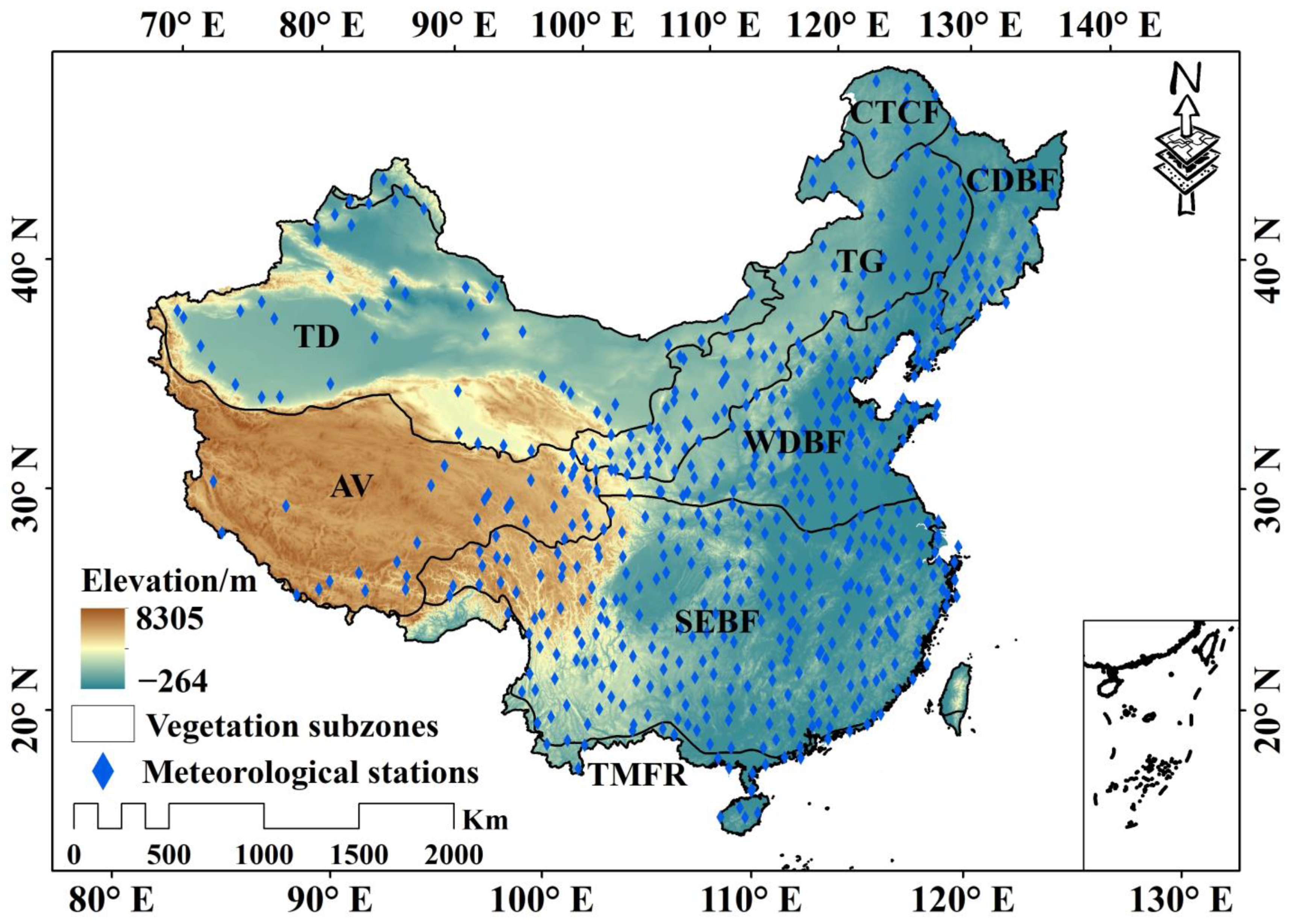
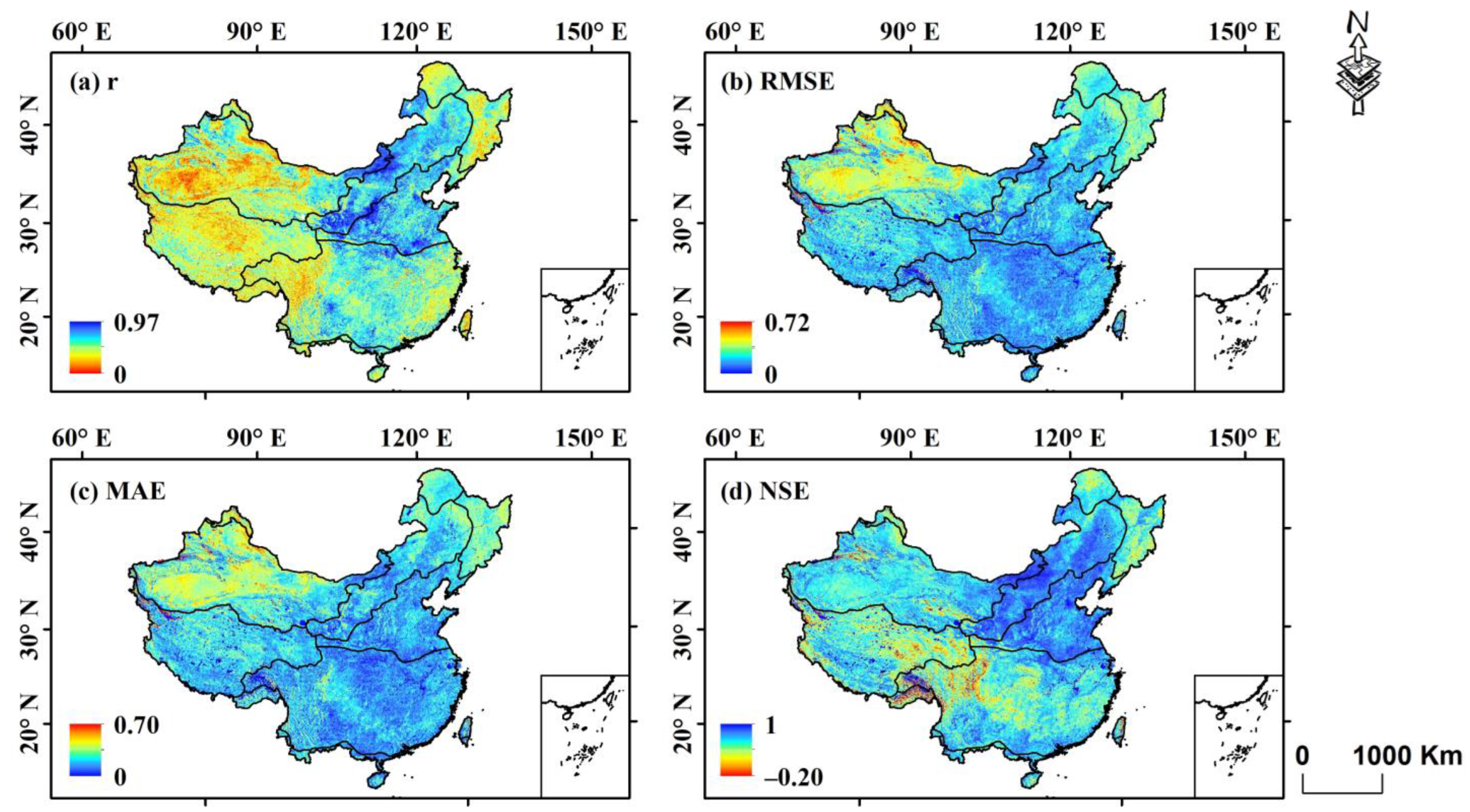
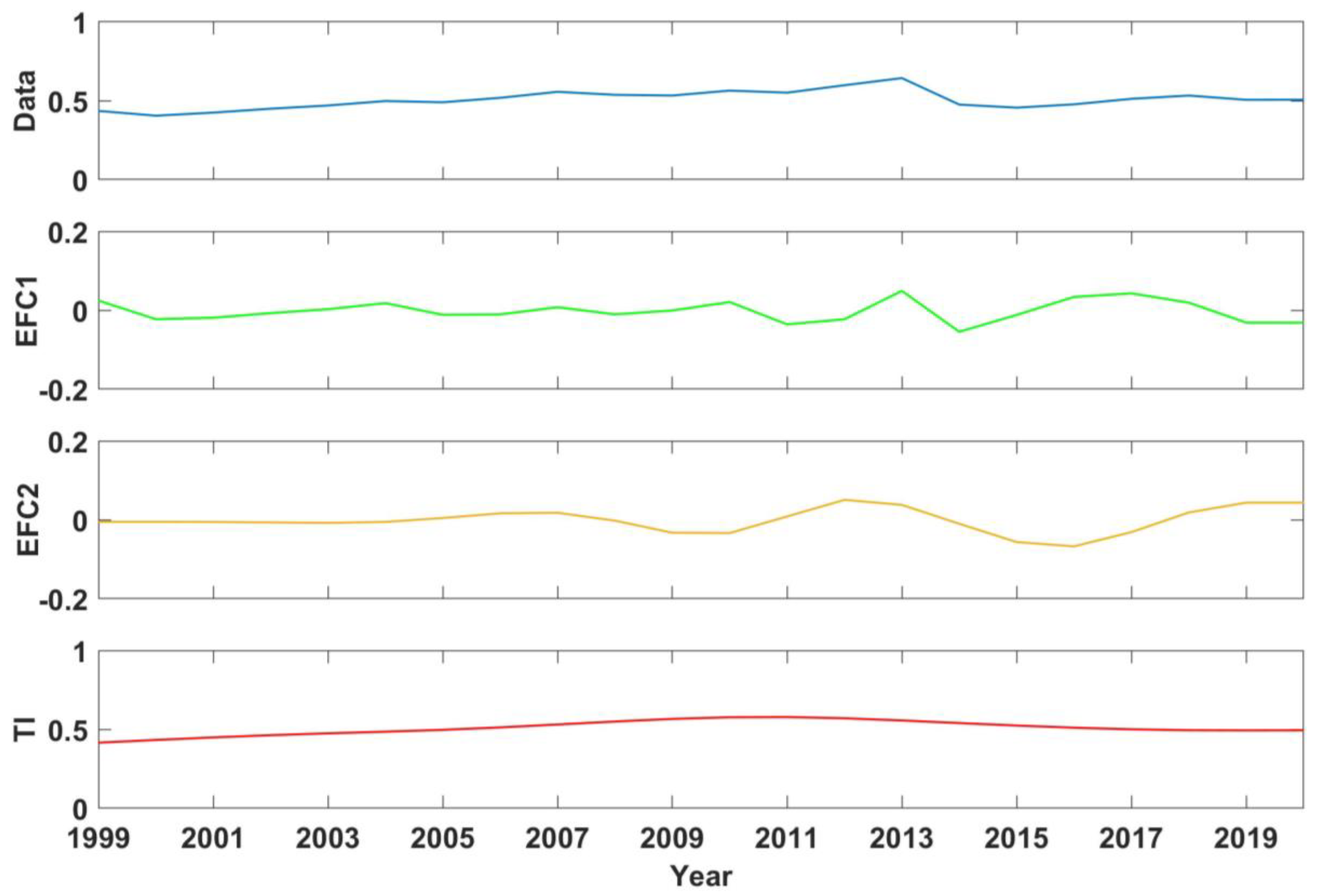
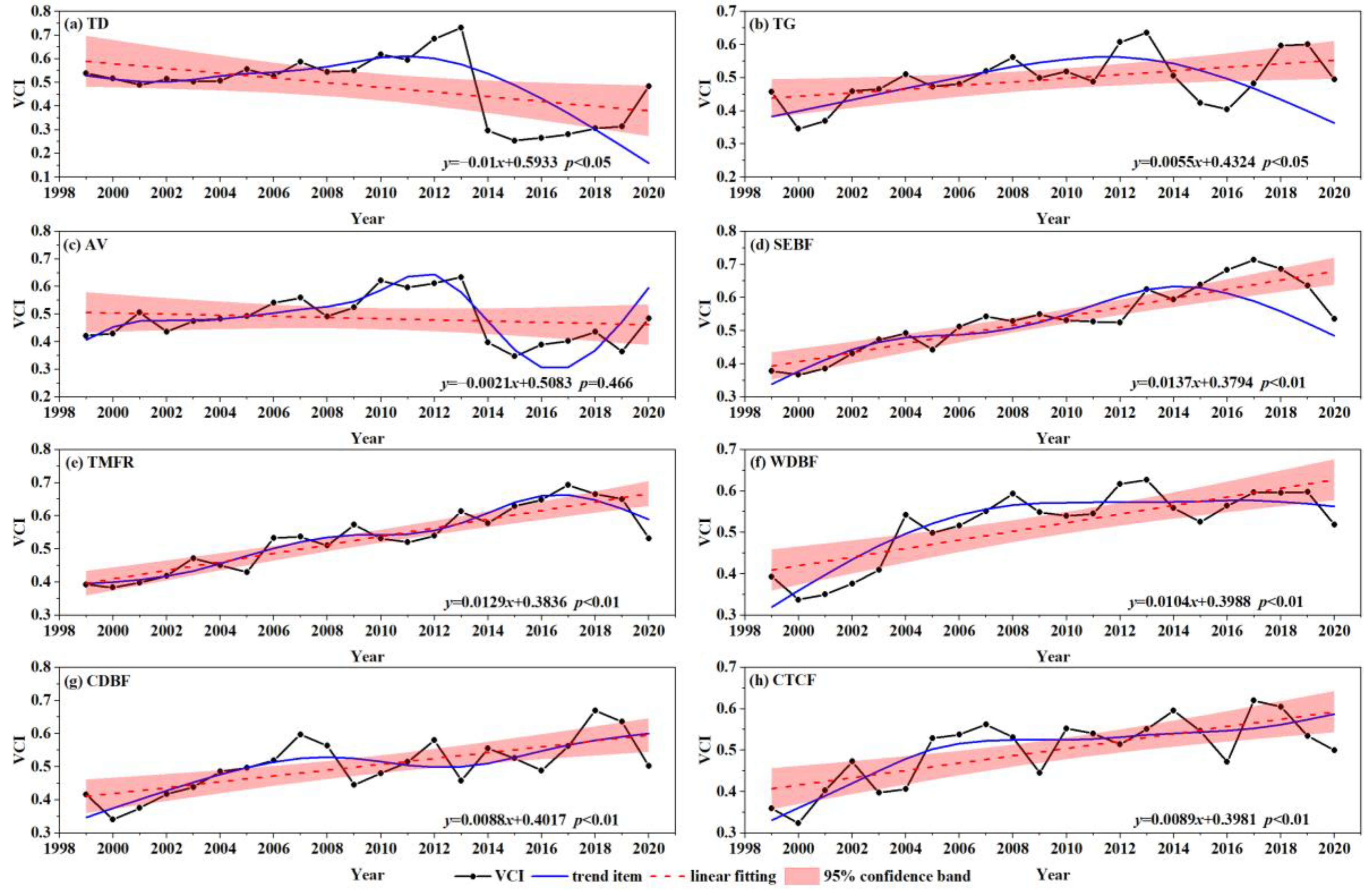
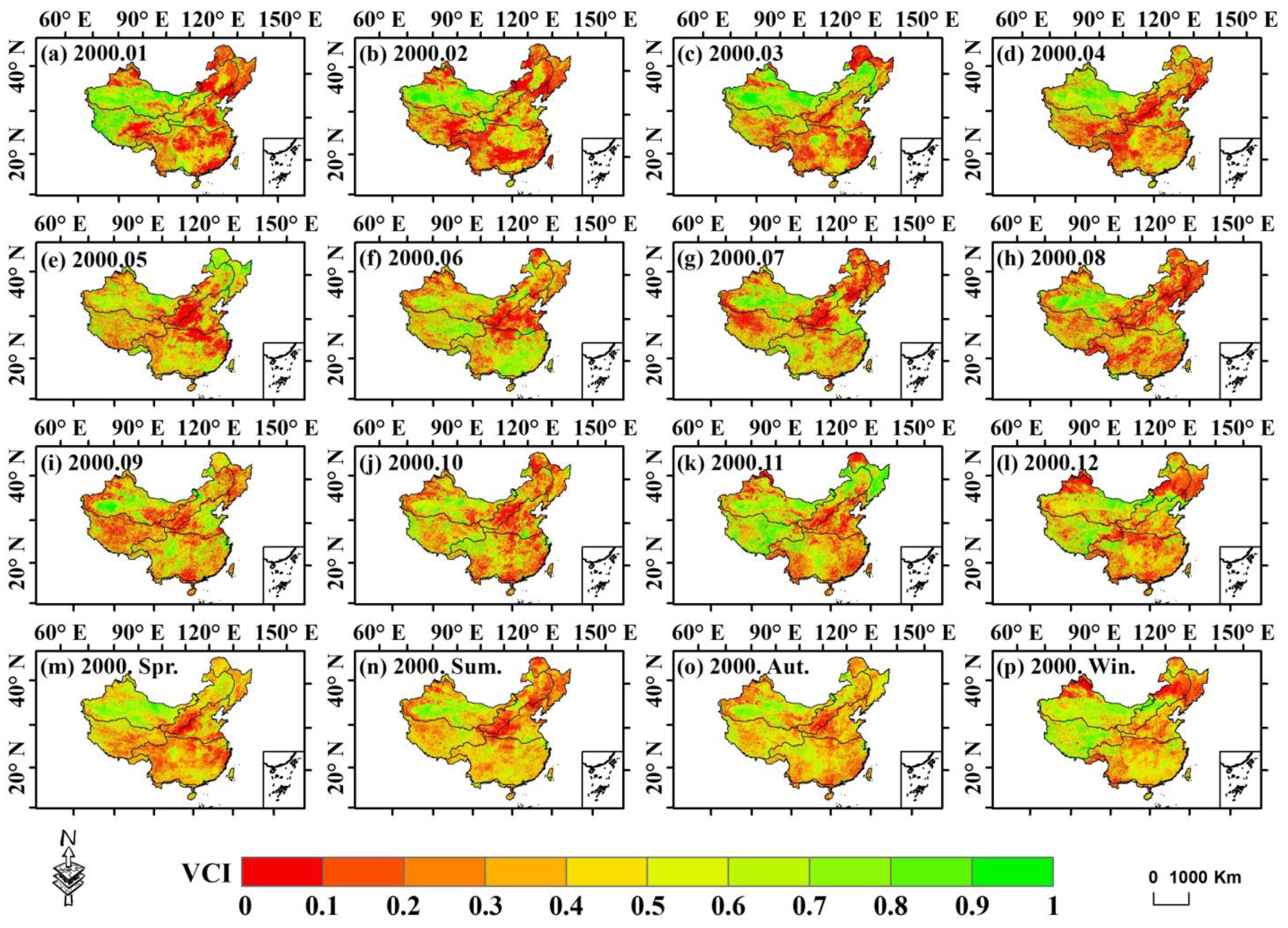
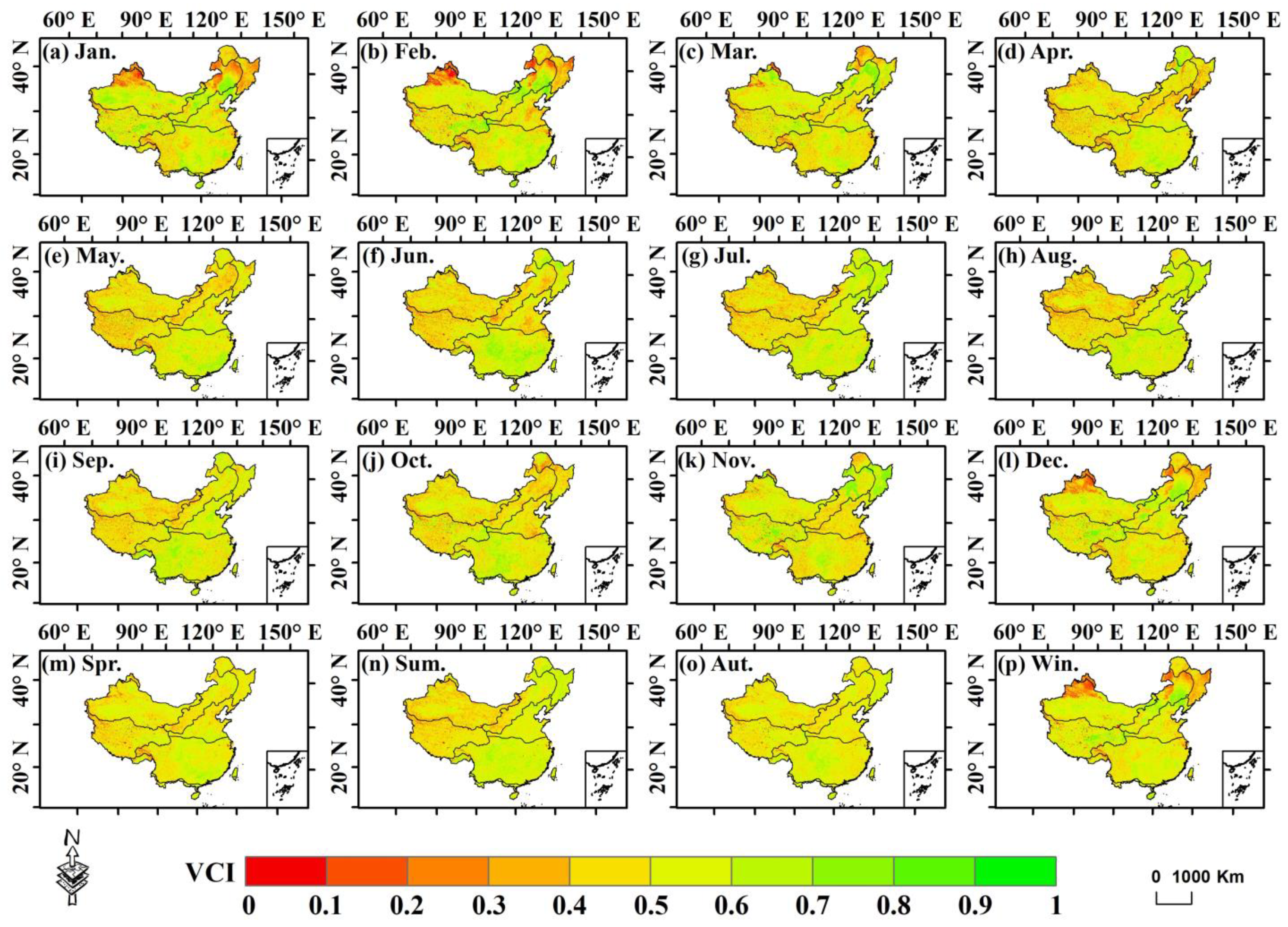
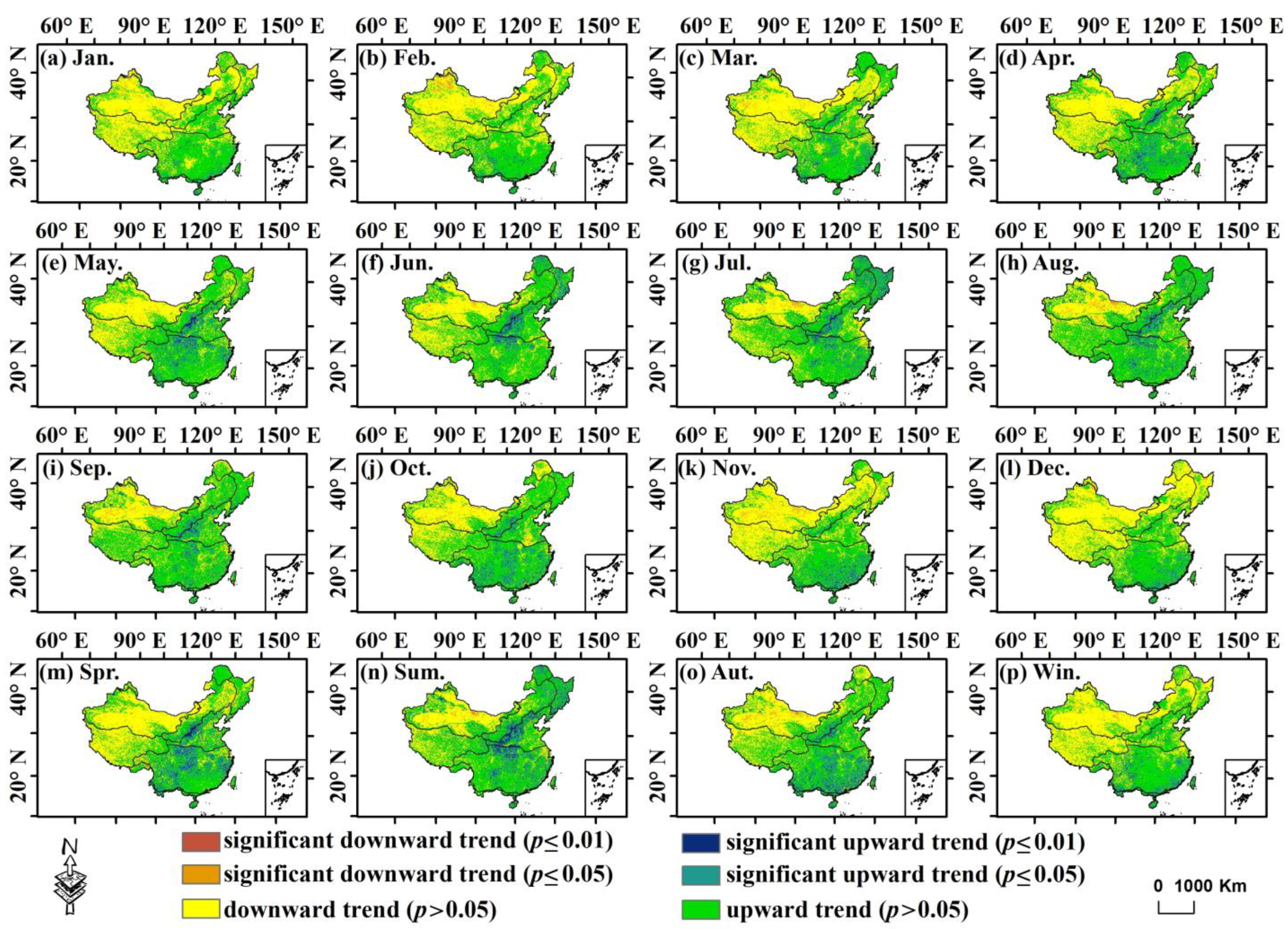





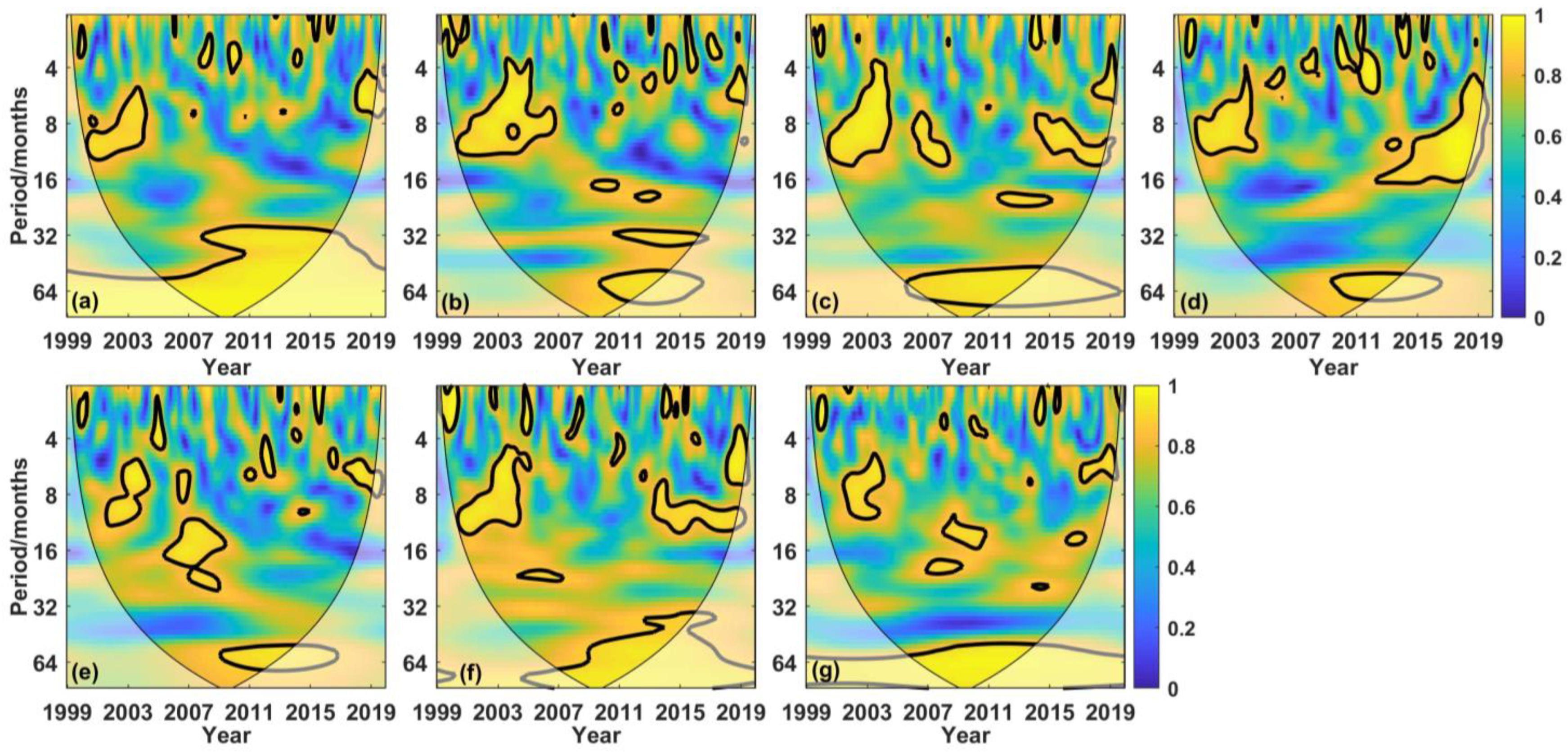

| Region | Abbreviation | Area (104 km2) | Number of Meteorological Stations |
|---|---|---|---|
| Temperate Desert | TD | 218.06 | 47 |
| Temperate Grassland | TG | 116.41 | 87 |
| Alpine Vegetation | AV | 160.59 | 34 |
| Subtropical Evergreen Broad-leaved Forest | SEBF | 267.08 | 259 |
| Tropical Monsoon Forest and Rainforest | TMFR | 28.96 | 19 |
| Warm-Temperate Deciduous Broad-leaved Forest | WDBF | 97.07 | 120 |
| Coniferous and Deciduous Broad-leaved Forest | CDBF | 40.84 | 35 |
| Cold-Temperate Coniferous Forest | CTCF | 20.79 | 6 |
| Mainland China | MC | 949.80 | 607 |
| Atmospheric Teleconnections | Acronym | Period |
|---|---|---|
| El Niño-Southern Oscillation | ENSO | 1999–2020 |
| Arctic Oscillation | AO | 1999–2020 |
| Southern Oscillation Index | SOI | 1999–2020 |
| Pacific North American | PNA | 1999–2020 |
| Sunspot Index | SI | 1999–2020 |
| Dipole Mode Index | DMI | 1999–2020 |
| Trans Polar Index | TPI | 1999–2020 |
| North Pacific Index | NPI | 1999–2020 |
| VCI Value | Jan. | Feb. | Mar. | Apr. | May. | Jun. | Jul. | Aug. | Sep. | Oct. | Nov. | Dec. | Spr. | Sum. | Aut. | Win. |
|---|---|---|---|---|---|---|---|---|---|---|---|---|---|---|---|---|
| Min. | 0.22 | 0.22 | 0.27 | 0.25 | 0.13 | 0.16 | 0.23 | 0.18 | 0.32 | 0.21 | 0.26 | 0.30 | 0.22 | 0.22 | 0.27 | 0.27 |
| Max. | 0.50 | 0.48 | 0.57 | 0.51 | 0.56 | 0.56 | 0.48 | 0.41 | 0.50 | 0.50 | 0.57 | 0.48 | 0.51 | 0.44 | 0.49 | 0.55 |
| Mean | 0.41 | 0.37 | 0.44 | 0.39 | 0.41 | 0.43 | 0.40 | 0.36 | 0.40 | 0.39 | 0.46 | 0.40 | 0.41 | 0.40 | 0.42 | 0.44 |
| One-Factor | AWC | PASC (%) | Two-Factors | AWC | PASC (%) | Three-Factors | AWC | PASC (%) |
|---|---|---|---|---|---|---|---|---|
| ENSO | 0.77 | 3.79 | PNA-ENSO | 0.94 | 25.60 | PNA-ENSO-AO | 0.97 | 24.66 |
| AO | 0.78 | 6.18 | PNA-AO | 0.91 | 11.75 | PNA-ENSO-SOI | 0.98 | 25.38 |
| SOI | 0.78 | 6.17 | PNA-SOI | 0.92 | 15.10 | PNA-ENSO-SI | 0.97 | 23.04 |
| PNA | 0.81 | 16.04 | PNA-SI | 0.91 | 13.16 | PNA-ENSO-DMI | 0.97 | 21.79 |
| SI | 0.81 | 15.14 | PNA-DMI | 0.90 | 8.77 | PNA-ENSO-TPI | 0.98 | 26.62 |
| DMI | 0.77 | 2.22 | PNA-TPI | 0.93 | 17.62 | PNA-ENSO-NPI | 0.97 | 20.58 |
| TPI | 0.78 | 7.87 | PNA-NPI | 0.93 | 16.75 | |||
| NPI | 0.79 | 9.43 |
Disclaimer/Publisher’s Note: The statements, opinions and data contained in all publications are solely those of the individual author(s) and contributor(s) and not of MDPI and/or the editor(s). MDPI and/or the editor(s) disclaim responsibility for any injury to people or property resulting from any ideas, methods, instructions or products referred to in the content. |
© 2023 by the authors. Licensee MDPI, Basel, Switzerland. This article is an open access article distributed under the terms and conditions of the Creative Commons Attribution (CC BY) license (https://creativecommons.org/licenses/by/4.0/).
Share and Cite
Gao, S.; Lai, H.; Wang, F.; Qiang, X.; Li, H.; Di, D. An Analysis of Spatial–Temporal Evolution and Propagation Features of Vegetation Drought in Different Sub-Zones of China. Agronomy 2023, 13, 2101. https://doi.org/10.3390/agronomy13082101
Gao S, Lai H, Wang F, Qiang X, Li H, Di D. An Analysis of Spatial–Temporal Evolution and Propagation Features of Vegetation Drought in Different Sub-Zones of China. Agronomy. 2023; 13(8):2101. https://doi.org/10.3390/agronomy13082101
Chicago/Turabian StyleGao, Shikai, Hexin Lai, Fei Wang, Xiaoman Qiang, Hao Li, and Danyang Di. 2023. "An Analysis of Spatial–Temporal Evolution and Propagation Features of Vegetation Drought in Different Sub-Zones of China" Agronomy 13, no. 8: 2101. https://doi.org/10.3390/agronomy13082101
APA StyleGao, S., Lai, H., Wang, F., Qiang, X., Li, H., & Di, D. (2023). An Analysis of Spatial–Temporal Evolution and Propagation Features of Vegetation Drought in Different Sub-Zones of China. Agronomy, 13(8), 2101. https://doi.org/10.3390/agronomy13082101





